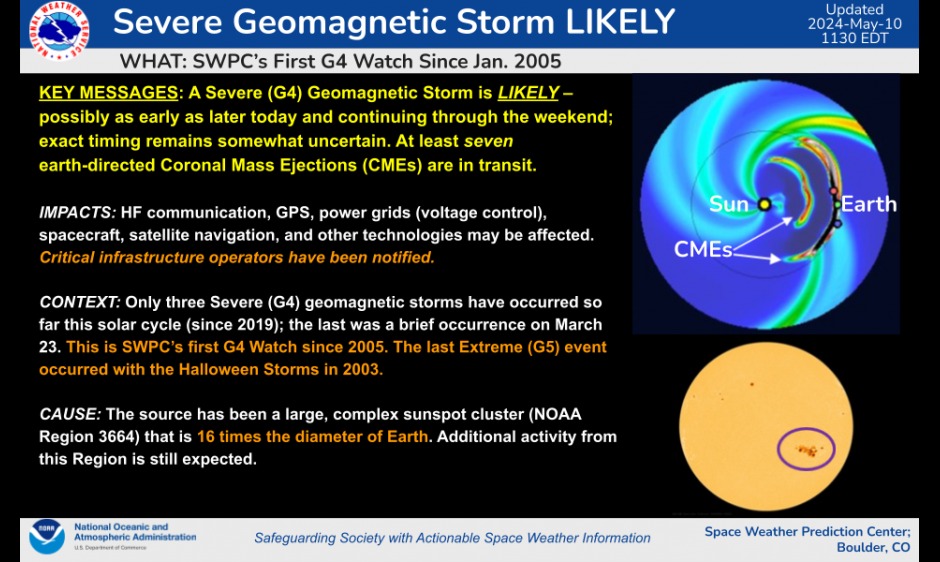A series of solar storms means the aurorae borealis may be visible as far south as northern California and Alabama.

An aurora arcs over a fjord on the Norwegian island of Senja, roughly 3° north of the Arctic Circle, lighting up the villages of Bergsbotn and Indregård. Credit: Marty Weintraub.
The most powerful solar storm to be forecast in nearly two decades is about to arrive at Earth late May 10, and could trigger auroral displays across much of the continental U.S. tonight and through this weekend.
This gathering cloud of plasma ejected from the Sun prompted U.S. government forecasters on May 9 to issue a severe geomagnetic storm watch — the first such watch in nearly 20 years. Formally, that’s a G-4 level watch, which ranks as the second highest level, behind a G-5. The watch is in effect for today (May 10) and through the weekend. And while power companies take measures to protect their grids and GPS users prepare for potential disruptions, solar astronomers and aurora watchers are rubbing their hands together in glee, because the Sun’s 11-year-long activity cycle just kicked into high gear.
A solar storm watch
The last time that the Space Weather Prediction Center (SWPC) at the National Oceanic and Atmospheric Administration (NOAA) issued a G-4 level watch was January 2005.
While space weather forecasting is subject to much uncertainty, the general definition of a G4-level storm includes aurorae visible potentially as far south as northern California and Alabama. (At maximum extent, the auroral oval tends to extend deeper into the Midwest toward the Gulf of Mexico than in other parts of the U.S.)
Of course, just like a tornado watch, a geomagnetic storm watch doesn’t mean that a storm of that strength will materialize. (Compare that to a tornado warning, which means a tornado has actually been detected.)

Space weather forecasters won’t be able to directly measure the approaching storm until it reaches satellites that are stationed at the L1 point between Earth and the Sun, roughly 1 million miles away. At that point, SWPC will begin issue geomagnetic storm warnings, if they are warranted. The storm is currently barrelling toward us at around 500 miles per second (800 km/s), said Shawn Dahl, a SWPC space weather forecaster, in a teleconference with media May 10. That means a storm warning will give satellite operators and power companies roughly 20 to 45 minutes of lead time before the storm begins to pound into our planet’s magnetic field.
A perfect storm
This storm is a result of an intense sequence over the past few days in which the Sun has spat out half a dozen clouds of plasma — or coronal mass ejections (CMEs) — all originating from a massive sunspot group known as AR3664 that has grown to around 125,000 miles (200,000 kilometers) across, or 16 times the diameter of the Earth. It is “one of the largest and more complex ones that we’ve seen in the solar cycle — perhaps the most complex one this solar cycle,” said Dahl.
These storms were all ejected at different speeds, meaning some of them are running into each other and merging into a larger, more powerful storm. “We have a very rare event on our hand,” said Dahl.
SWPC forecasters say current models predict the storm will arrive around 8 P.M. EDT, but they caution that there is quite a bit of uncertainty in that forecast and it could arrive a few hours before or after.
Even if timing and weather isn’t ideal for aurora watchers tonight, the storm could well continue through the weekend. “This sunspot cluster has been sending off new, very large, coronal mass ejections about every 6 to 12 hours,” said Brent Gordon, head of SWPC’s space weather services branch. “And the latest one happened overnight, about 3 A.M. EDT. We anticipate that we’re going to get one shock after another in the weekend. So we’re really buckling down here to see what we get at this point.”
How to see the aurora
Hunting for aurorae is one of the most accessible forms of visual astronomy. All you have to do is find a good dark-sky site, a clear horizon, and look north — in the Northern Hemisphere, of course. (In the Southern Hemisphere, a G4-level storm could generate aurorae visible at dark-sky sites as far north as Sydney and Perth.) The best time to observe is around midnight, when the auroral oval is typically farthest south and the sky is darkest.
Keep in mind that if your dark-adapted eyes can’t see anything, a camera — even the one on your phone, in night mode — may well be able to capture aurorae that you cannot. And if you snag a good shot, send it to us at readergallery@astronomy.com!

